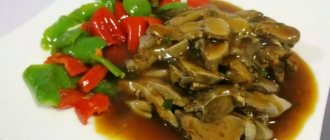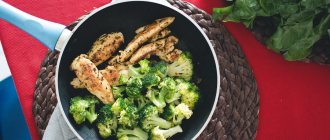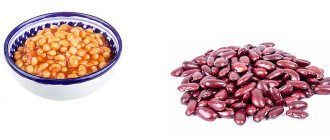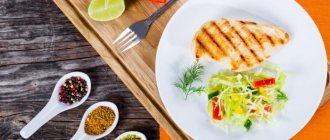Liver is an offal that we are used to using to prepare various dishes. And athletes add it to their diet when they need to lose weight. It can be boiled, stewed, fried.
In appearance, a good fresh liver should be uniform in color and smooth. The structure looks a little different. If it is a young calf, then it will be more loose and soft. Weight is usually from two to five kilograms.
The liver reaches the shelves already processed: without bile ducts, bladder, blood vessels and lymph nodes.
Benefits of beef liver
It is generally accepted that the liver is a filter in the animal’s body, so it collects all harmful substances. Despite this, it has been scientifically proven that it is very beneficial for humans. And only if the animal was poorly fed and the food contained chemical elements, the organ will be contaminated. If the conditions were met, the animal was raised in an ecological environment, then the product will be pure.
Almost all doctors: nutritionists, cardiologists, immunologists recommend regularly including beef liver in your diet, and here’s why:
- Helps fight anemia due to its high iron content;
- Quickly restores strength after high physical activity. Therefore, it is always used by professional athletes. In addition, a large amount of protein helps to gain muscle mass;
- Low calorie content makes liver a dietary product. A specially designed diet allows you to get rid of 6-8 extra pounds in two weeks;
- The folic acid contained in the product makes the product useful for pregnant women. This is especially true for those who are still in the early stages. Regular consumption of liver protects a woman’s body from possible miscarriage;
- Antioxidants such as selenium and thiamine neutralize the negative effects of alcohol and smoking;
- Improves immunity well;
- Strengthens the heart, makes blood vessels more resilient;
- Due to potassium, it normalizes kidney function and removes excess fluid from the body;
- Vitamin A is a good prevention of eye disease.
The liver contains heparin, which controls the level of blood clotting, thereby preventing heart attack.
Dishes prepared without fat are suitable for diabetics and people with metabolic disorders.
Recommended for those with heavy eye strain. It is best consumed together with carrot salads and bell peppers.
In order for the liver to become a real source of protein, you should not cook it with vegetable oil or fatty sauces.
Video
The most complete information about beef liver, its benefits, rules for selection and preparation.
You've probably eaten beef liver more than once. This is a healthy and tasty product that is prepared very quickly, which is also important for the housewife. It can be used in dietary nutrition, following the rules of use. This is a magical product for raising hemoglobin.
You need to limit its consumption only if you have already accumulated bad cholesterol in your blood vessels. But we hope that you don’t have this, and you will tell us about your secrets of preparing and eating beef liver.
Beef liver is an easily accessible and most favorite offal among cooks and housewives.
The texture of the liver is very tender due to the large amount of water in its composition. In this regard, it is very difficult to store liver - it easily spoils.
Calorie content of fried beef liver
The calorie content of fried beef liver is 199 kcal per 100 grams of product.
Composition of fried beef liver
The liver contains a lot of protein and very little fat. An interesting fact is that the minerals in beef carcass are found mainly in the liver. These are iron, selenium, phosphorus, calcium, magnesium and others. It is the liver that is the main source of vitamins D, A, B12, C and the entire B group.
Health benefits of fried beef liver
The amount of vitamins and amino acids is so great that one serving of beef liver can provide a daily, or even monthly, intake of vitamins.
Beef liver is a very valuable dietary product necessary for many diseases in people of completely different ages.
Beef liver fried in cooking
Liver dishes are good both at festive feasts and on the everyday menu. The liver is used as a component in a “complex” dish or “solo” with various side dishes - it is good and healthy everywhere.
A culinary disadvantage of liver may be that it tastes bitter. This can be easily remedied by soaking the liver in milk for an hour.
You can prepare liver in many ways - boil, stew, make pate, bake liver pies. But perhaps the fastest and easiest way to diversify the menu is to fry the liver (calorizer). To maintain juiciness and maximum benefit, fry the liver pieces on each side for no more than 3 minutes. Serve with any fresh or stewed vegetables. Do not interrupt the rich taste of the liver with unnecessary spices.
Nutritionists unanimously insist that for human health it is necessary, first of all, to organize proper and balanced nutrition. This can only be achieved if the daily menu contains foods containing beneficial vitamins and minerals necessary for the human body. One of the products whose value is beyond doubt is liver, an offal widely used in the cuisines of different nations of the world.
Since the calorie content of liver is low, it is successfully used in dietary nutrition systems and allows people to fight excess weight and keep fit, while at the same time providing the body with the necessary nutrients. The most popular types of liver, most often present in the menu of a modern person, are pork and beef liver.
Chemical composition and nutritional value of the liver
| Nutrient | Quantity per 100 g of product |
| Calorie content | 127 kcal |
| Squirrels | 17.9 g |
| Fats | 3.5 g |
| Carbohydrates | 5.2 g |
| Water | 71 g |
| Ash | 1.4 g |
| Retinol | 8 mg |
| Vitamin A | 8367 mcg |
| Vitamin B1 | 0.3 mg |
| Vitamin B2 | 2.19 mg |
| Vitamin B4 | 635 mg |
| Vitamin B5 | 6.8 mg |
| Vitamin B6 | 0.7 mg |
| Vitamin B9 | 240 mcg |
| Vitamin B12 | 60 mcg |
| Vitamin C | 33 mg |
| Vitamin E | 0.9 mg |
| Vitamin K | 3 mcg |
| Vitamin D | 1.2 mcg |
| Vitamin H | 98 mcg |
| Vitamin PP | 13 mg |
| Chlorine | 98 mg |
| Phosphorus | 310 mg |
| Potassium | 270 mg |
| Magnesium | 18 mg |
| Calcium | 8 mg |
| Sodium | 100 mg |
| Sulfur | 235 mg |
| Iodine | 6.3 mcg |
| Cobalt | 19 mcg |
| Copper | 3800 mcg |
| Chromium | 32 mcg |
| Zinc | 4 mcg |
| Fluorine | 220 mcg |
| Nickel | 63 mcg |
| Manganese | 0.3 mcg |
| Molybdenum | 100 mcg |
| Selenium | 38 mcg |
| Iron | 6.5 mcg |
How many calories are in pork liver:
First of all, we note that pork liver is a source of essential amino acids and B vitamins. In addition, this product contains vitamins A, D, E, K, as well as minerals - copper, phosphorus, sodium, magnesium, iron. Pork liver (like its other types) will be useful for people with low hemoglobin, as well as those who suffer from atherosclerosis and diabetes.
The caloric content of pork liver is 120 kcal per 100 g. product
The liver allows you to prepare many dishes, but for dietary nutrition you should choose low-calorie ones. For example, the calorie content of fried liver with flour and butter is 219 kcal, and the calorie content of stewed liver with sour cream and carrots is 133 kcal.
Liver calories
Beef liver itself is a low-calorie product with a lot of protein. That is why it is often used for weight loss. Of course, depending on the cooking method, the nutritional value will vary. If you fry a product using vegetable oil, then it will be difficult to call it a dietary dish. In order to get rid of extra pounds, it is better to steam, boil or stew.
Calorie table
| Product | Calorie content per 100 g |
| Boiled liver | 115 kcal |
| Fried liver | 185 Kcal |
| Steamed liver | 125 kcal |
| Stewed liver | 120 kcal |
| Liver in sour cream | 130 kcal |
What are the best beef by-product dishes to prepare?
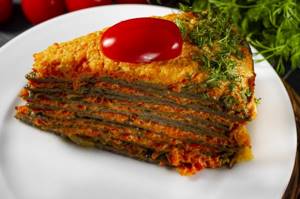
The number of dishes made from this offal is simply huge! If you take boiled liver as a basis, it will become an ideal component of salads, casseroles, and pates. Boiled offal is also a good filling for baking. It is fried in batter, baked on the grill, and the liver makes delicious cutlets and beef stroganoff.
Love savory treats? Combine beef liver with prunes, apples, figs and oranges. And if you don’t know what side dish to choose for it, pay attention to legumes, potatoes, vegetables, pasta and porridge.
Secrets of juicy and tender-tasting liver:
- The offal must be freed from film and ducts, otherwise it will taste bitter. To make this easier, first keep the liver in the freezer for half an hour.
- To make the liver tender, fill it with milk and leave for a couple of hours. This offal is also soaked in lemon juice. Such a treat will have a unique, exquisite taste.
- Do not fry the liver for a long time, otherwise the dish will be tough.
Liver recipe for weight loss
Ingredients:
- Liver – 200 g;
- One small onion;
- Water;
- Low-fat sour cream – up to 15%;
- Seasonings to taste.
Preparation:
- Rinse the liver under water, preferably keeping it cool enough.
- Finely chop the onion and fry it in a frying pan.
- Then add the liver there.
- The total frying time is no more than four minutes. After this time, add water, sour cream, salt, and pepper to the pan.
- Simmer the dish for about 20 minutes over low heat, stirring occasionally.
Mineral composition
The ratio of mineral substances (macro- and microelements) contained in stewed or boiled beef liver is presented in the table using diagrams.
Minerals, content Share of the daily norm g 100 per
| Calcium | 6.0 mg | 0,6% |
| Iron | 6.5 mg | 65,4% |
| Magnesium | 21.0 mg | 5,3% |
| Phosphorus | 497.0 mg | 71,0% |
| Potassium | 352.0 mg | 7,5% |
| Sodium | 79.0 mg | 6,1% |
| Zinc | 5.3 mg | 48,2% |
| Copper | 14.3 mg | 1 587,0% |
| Manganese | 0.4 mg | 15,5% |
| Selenium | 36.1 mcg | 65,6% |
| Fluorine | n/a | 0,0% |
Cooking secrets
The liver has a characteristic hue and a slightly bitter taste. You can get rid of this by leaving the product in milk for two hours.
During cooking, moisture comes out and evaporates, so the liver becomes dry and tough. In order to preserve as many useful elements as possible when frying the product, you need to add salt to the dish at the very end of cooking.
During the diet, you should eat no more than 100 grams of boiled or stewed liver along with vegetables at one time. This is exactly the amount of liver that promotes better absorption, satisfies hunger, and has the necessary amount of protein to provide the body with building material.
Why you should include liver in your diet
The calorie content of stewed or boiled chicken liver is not the only reason why you should include this product in your diet. This product can easily replace beef or pork in the diet. In addition, a large amount of vitamin A makes this product a good aid in maintaining vision, skin health, and normal blood functioning in the body.
It is recommended to use liver for the following diseases:
- Chronic fatigue.
- Severe fatigue.
- Heart and lung diseases.
- Weakened immunity.
Of course, it should be understood that the liver will have a preventive and supportive effect. You should not try to cure yourself with such a product, as this can only worsen your condition.
Benefits for weight loss
Beef liver is a healthy product with low calorie content and high protein content, which is necessary for the formation of connective tissue, muscles and bones. That is why the offal is an integral element of various diets. The so-called liver diet has become widely known.
Judging by the reviews, it effectively helps fight excess weight and lose up to 8 kg per week. This result is achieved due to the low energy value of the offal.
Protein in the liver causes a feeling of fullness, potassium helps remove excess fluid from the body, antioxidants help cleanse tissues of toxins, and vitamins strengthen the immune and nervous systems.
Glycemic index
The effect of beef liver on blood sugar levels is determined by the way it is prepared. The glycemic index can range from 50 to 100 points. If it is minimal, the use of the product for diabetes is completely permitted. But rolling in flour, using spices and hot seasonings is strictly prohibited.
Diabetics are advised to eat liver no more than three times a week, consuming servings of a maximum of 150 g.

Vitamins
Of the fat-soluble vitamins, beef liver contains A, beta-carotene, alpha-carotene, D, D3, E and K. Of the water-soluble vitamins, there are vitamins C, B1, B2, B3 (PP), B4, B5, B6, B9 and B12.
Vitamins, content Share of the daily norm g 100 per
| Vitamin A | 4,968.0 mcg | 552,0% |
| Beta carotene | 232.0 mcg | 4,6% |
| Alpha carotene | 11.0 mcg | 0,2% |
| Vitamin D | 1.2 mcg | 8,0% |
| Vitamin D2 | n/a | 0,0% |
| Vitamin D3 | 1.2 mcg | 7,4% |
| Vitamin E | 0.4 mg | 2,6% |
| Vitamin K | 3.1 mcg | 2,6% |
| Vitamin C | 1.3 mg | 1,4% |
| Vitamin B1 | 0.2 mg | 15,8% |
| Vitamin B2 | 2.8 mg | 211,9% |
| Vitamin B3 | 13.2 mg | 82,3% |
| Vitamin B4 | 333.3 mg | 66,7% |
| Vitamin B5 | 7.2 mg | 143,5% |
| Vitamin B6 | 1.1 mg | 83,3% |
| Vitamin B9 | 290.0 mcg | 72,5% |
| Vitamin B12 | 59.3 mcg | 2 470,8% |
